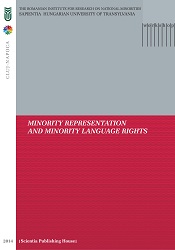
From Law to Language Use Practices – A Case Study on Hungarian-Speakers in Austria
In Austria, there are two substantial Hungarian communities, namely the autochthonous minority of Burgenland and the more recent migrant groups in Vienna. Importantly, the latter have arrived in different waves and from various Hungarian-speaking regions of the Carpathian Basin, which clearly adds to the diversity of the community. In this respect, the Austrian context seems to be quite unique. Both Hungarians in Burgenland and Vienna are formally recognized minorities, yet – due to the fact that Austrian minority rights are not harmonized on various levels – the two groups do not enjoy the same level of protection, which is most dominant with regard to the mother-tongue instruction within the educational system and in the area of official language use. It is also due to these differences that the language use patterns of Hungarian-speakers in Burgenland greatly differ from those living in Vienna. It has further been argued that although the existing regulations of minority language protection in Austria are extensive, their implementation has not been achieved without shortfalls. Therefore, the aim of the present paper is to identify how regulations of minority language rights protection influence actual language use practices reported by the speakers themselves. The case study on the Hungarian-speakers in Austria was conducted within the international and interdisciplinary FP7 project ELDIA (European Language Diversity for All).1 The research, having a special focus on the legislative and institutional framework of language use and language use in practice, has shown that there are clear gaps between legal regulations and actual practices. It will be demonstrated that Hungarian-speakers have relatively little opportunity to use Hungarian in the public domains. The language use patterns reported by the informants show that the use of Hungarian is restricted mainly to the home context. Nevertheless, it will be argued that Hungarian has an exceptionally strong presence within the community for there is a clearly identifiable demand and willingness to use the Hungarian language and to develop it to the speakers’ changing needs.
More...



